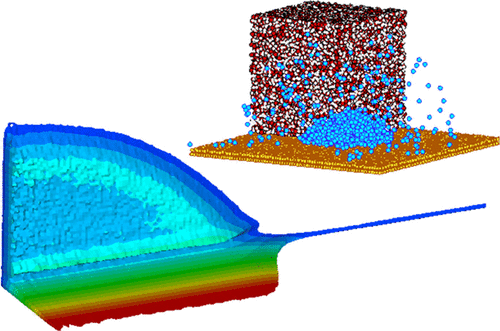Our official English website, www.x-mol.net, welcomes your
feedback! (Note: you will need to create a separate account there.)
Effects of Gas Adsorption and Surface Conditions on Interfacial Nanobubbles
Langmuir ( IF 3.7 ) Pub Date : 2021-02-17 , DOI: 10.1021/acs.langmuir.0c03511 Tsu-Hsu Yen, Chia-He Lin, Yeng-Long Chen
Langmuir ( IF 3.7 ) Pub Date : 2021-02-17 , DOI: 10.1021/acs.langmuir.0c03511 Tsu-Hsu Yen, Chia-He Lin, Yeng-Long Chen

|
Gas aggregation and formation of interfacial nanobubbles (INBs) provide challenges and opportunities in the operation of micro-/nanofluidic devices. In the current study, we used molecular dynamics(MD) simulations to investigate the effects of hydrophobicity and various homogeneous surface conditions on gas aggregation and INB stability with a series of 3D argon–water–solid and water–solid systems. Among various signatures of surface hydrophobicity, the potential of mean force (PMF) minima exhibited the strongest correlation with the water molecular orientation at the liquid–solid interface, compared to the depletion layer width and the droplet contact angle. Our results indicated that argon aggregation on the substrate was a function of hydrophobicity as well as competition between gas–solid and water–solid PMFs. Thus, one precondition for gas aggregation on a surface is that the free energy minima of gas induced by the surface be much lower than that induced by water. We found that although the presence of gas molecules had little effect on the measures of wettability, it enhanced density fluctuations near liquid–solid interfaces. The PMF of gas along the surface tangential plane exhibited a small energy barrier between the epitaxial gas layer (EGL) in the bubble and the gas enrichment layer (GEL) in the liquid, which may benefit nanobubble stability. Much lower PMF in the EGL compared to that in the GEL indicated that gas molecules could migrate from the GEL to the nanobubble basement. However, density fluctuations enhanced by the GEL could reduce the energy barrier, thus reducing the stability of INBs.
中文翻译:

气体吸附和表面条件对界面纳米气泡的影响
气体聚集和界面纳米气泡(INB)的形成为微/纳米流体装置的操作带来了挑战和机遇。在当前的研究中,我们使用分子动力学(MD)模拟研究了一系列3D氩气-水-固体和水-固体系统对疏水性和各种均匀表面条件对气体聚集和INB稳定性的影响。在表面疏水性的各种特征中,与耗尽层的宽度和液滴的接触角相比,最小均势(PMF)与液-固界面处的水分子取向表现出最强的相关性。我们的结果表明,氩气在底物上的聚集是疏水性以及气固PMF与水固PMF之间竞争的函数。因此,表面上气体聚集的一个先决条件是,表面诱导的气体的自由能最小值比水诱导的自由能最小值低得多。我们发现,尽管气体分子的存在对润湿性的测量影响很小,但它增加了液-固界面附近的密度波动。沿着表面切线平面的气体的PMF在气泡中的外延气体层(EGL)和液体中的气体富集层(GEL)之间显示出小的能垒,这可能有利于纳米气泡的稳定性。与GEL相比,EGL中的PMF低得多,这表明气体分子可以从GEL迁移到纳米气泡基底。但是,由GEL增强的密度波动可能会减小能垒,从而降低INB的稳定性。
更新日期:2021-03-02
中文翻译:

气体吸附和表面条件对界面纳米气泡的影响
气体聚集和界面纳米气泡(INB)的形成为微/纳米流体装置的操作带来了挑战和机遇。在当前的研究中,我们使用分子动力学(MD)模拟研究了一系列3D氩气-水-固体和水-固体系统对疏水性和各种均匀表面条件对气体聚集和INB稳定性的影响。在表面疏水性的各种特征中,与耗尽层的宽度和液滴的接触角相比,最小均势(PMF)与液-固界面处的水分子取向表现出最强的相关性。我们的结果表明,氩气在底物上的聚集是疏水性以及气固PMF与水固PMF之间竞争的函数。因此,表面上气体聚集的一个先决条件是,表面诱导的气体的自由能最小值比水诱导的自由能最小值低得多。我们发现,尽管气体分子的存在对润湿性的测量影响很小,但它增加了液-固界面附近的密度波动。沿着表面切线平面的气体的PMF在气泡中的外延气体层(EGL)和液体中的气体富集层(GEL)之间显示出小的能垒,这可能有利于纳米气泡的稳定性。与GEL相比,EGL中的PMF低得多,这表明气体分子可以从GEL迁移到纳米气泡基底。但是,由GEL增强的密度波动可能会减小能垒,从而降低INB的稳定性。











































 京公网安备 11010802027423号
京公网安备 11010802027423号